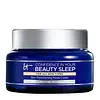What's inside
What's inside
 Key Ingredients
Key Ingredients

 Benefits
Benefits

 Concerns
Concerns

 Ingredients Side-by-side
Ingredients Side-by-side

Water
Skin ConditioningStearic Acid
CleansingNeopentyl Glycol Diheptanoate
EmollientCetearyl Olivate
Sorbitan Olivate
EmulsifyingHydrogenated Poly(C6-14 Olefin)
EmollientGlycerin
HumectantCyclomethicone
EmollientButylene Glycol
HumectantCopper Tripeptide-1
Skin ConditioningGlyceryl Stearate
EmollientPEG-100 Stearate
Polyacrylate-13
Polyisobutene
Polysorbate 20
EmulsifyingCetearyl Alcohol
EmollientCetearyl Glucoside
EmulsifyingDimethicone
EmollientTrehalose
HumectantTheobroma Cacao Extract
Skin ConditioningCaprylyl Glycol
EmollientAmmonium Acryloyldimethyltaurate/Vp Copolymer
Triethanolamine
BufferingCoptis Japonica Extract
AntimicrobialAdenosine
Skin ConditioningPropylene Glycol
HumectantHydrolyzed Extensin
Skin ConditioningRubus Idaeus Fruit Extract
AstringentBeta-Glucan
Skin ConditioningBiosaccharide Gum-1
HumectantIris Ensata Extract
Skin ConditioningHydrolyzed Wheat Protein
Skin ConditioningPrunus Amygdalus Dulcis Seed Extract
Skin ConditioningLavandula Angustifolia Oil
MaskingDisodium EDTA
Water, Stearic Acid, Neopentyl Glycol Diheptanoate, Cetearyl Olivate, Sorbitan Olivate, Hydrogenated Poly(C6-14 Olefin), Glycerin, Cyclomethicone, Butylene Glycol, Copper Tripeptide-1, Glyceryl Stearate, PEG-100 Stearate, Polyacrylate-13, Polyisobutene, Polysorbate 20, Cetearyl Alcohol, Cetearyl Glucoside, Dimethicone, Trehalose, Theobroma Cacao Extract, Caprylyl Glycol, Ammonium Acryloyldimethyltaurate/Vp Copolymer, Triethanolamine, Coptis Japonica Extract, Adenosine, Propylene Glycol, Hydrolyzed Extensin, Rubus Idaeus Fruit Extract, Beta-Glucan, Biosaccharide Gum-1, Iris Ensata Extract, Hydrolyzed Wheat Protein, Prunus Amygdalus Dulcis Seed Extract, Lavandula Angustifolia Oil, Disodium EDTA
Water
Skin ConditioningDimethicone
EmollientGlycerin
HumectantSimmondsia Chinensis Seed Oil
EmollientHydrogenated Castor Oil Dimer Dilinoleate
Skin ConditioningPropanediol
SolventAlcohol Denat.
AntimicrobialCaprylic/Capric Triglyceride
MaskingCetyl Alcohol
EmollientCetyl Hydroxyethylcellulose
Emulsion StabilisingOctyldodecanol
EmollientSilica
AbrasivePhenoxyethanol
PreservativeAlbizia Julibrissin Bark Extract
MaskingCaprylyl Glycol
EmollientParfum
MaskingPoloxamer 338
EmulsifyingCapryloyl Salicylic Acid
ExfoliatingLimonene
PerfumingAdenosine
Skin ConditioningTocopherol
AntioxidantXanthan Gum
EmulsifyingDisodium EDTA
Linalool
PerfumingCeramide NP
Skin ConditioningHydroxypalmitoyl Sphinganine
Skin ConditioningSilica Dimethyl Silylate
EmollientHydrated Silica
AbrasiveSodium Hyaluronate
HumectantPolysorbate 60
EmulsifyingCitronellol
PerfumingSodium Benzoate
MaskingCI 16035
Cosmetic ColorantGeraniol
PerfumingCereus Grandiflorus Flower Extract
Skin ConditioningCitral
PerfumingDarutoside
Skin ConditioningCI 42090
Cosmetic ColorantGlucose
HumectantLactic Acid
BufferingPotassium Sorbate
PreservativeWater, Dimethicone, Glycerin, Simmondsia Chinensis Seed Oil, Hydrogenated Castor Oil Dimer Dilinoleate, Propanediol, Alcohol Denat., Caprylic/Capric Triglyceride, Cetyl Alcohol, Cetyl Hydroxyethylcellulose, Octyldodecanol, Silica, Phenoxyethanol, Albizia Julibrissin Bark Extract, Caprylyl Glycol, Parfum, Poloxamer 338, Capryloyl Salicylic Acid, Limonene, Adenosine, Tocopherol, Xanthan Gum, Disodium EDTA, Linalool, Ceramide NP, Hydroxypalmitoyl Sphinganine, Silica Dimethyl Silylate, Hydrated Silica, Sodium Hyaluronate, Polysorbate 60, Citronellol, Sodium Benzoate, CI 16035, Geraniol, Cereus Grandiflorus Flower Extract, Citral, Darutoside, CI 42090, Glucose, Lactic Acid, Potassium Sorbate
 Reviews
Reviews

Ingredients Explained
These ingredients are found in both products.
Ingredients higher up in an ingredient list are typically present in a larger amount.
Adenosine is in every living organism. It is one of four components in nucleic acids that helps store our DNA.
Adenosine has many benefits when used. These benefits include hydrating the skin, smoothing skin, and reducing wrinkles. Once applied, adenosine increases collagen production. It also helps with improving firmness and tissue repair.
Studies have found adenosine may also help with wound healing.
In skincare products, Adenosine is usually derived from yeast.
Learn more about AdenosineCaprylyl Glycol is a humectant and emollient, meaning it attracts and preserves moisture.
It is a common ingredient in many products, especially those designed to hydrate skin. The primary benefits are retaining moisture, skin softening, and promoting a healthy skin barrier.
Though Caprylyl Glycol is an alcohol derived from fatty acids, it is not the kind that can dry out skin.
This ingredient is also used as a preservative to extend the life of products. It has slight antimicrobial properties.
Learn more about Caprylyl GlycolDimethicone is a type of synthetic silicone created from natural materials such as quartz.
What it does:
Dimethicone comes in different viscosities:
Depending on the viscosity, dimethicone has different properties.
Ingredients lists don't always show which type is used, so we recommend reaching out to the brand if you have questions about the viscosity.
This ingredient is unlikely to cause irritation because it does not get absorbed into skin. However, people with silicone allergies should be careful about using this ingredient.
Note: Dimethicone may contribute to pilling. This is because it is not oil or water soluble, so pilling may occur when layered with products. When mixed with heavy oils in a formula, the outcome is also quite greasy.
Learn more about DimethiconeDisodium EDTA plays a role in making products more stable by aiding other preservatives.
It is a chelating agent, meaning it neutralizes metal ions that may be found in a product.
Disodium EDTA is a salt of edetic acid and is found to be safe in cosmetic ingredients.
Learn more about Disodium EDTAGlycerin is already naturally found in your skin. It helps moisturize and protect your skin.
A study from 2016 found glycerin to be more effective as a humectant than AHAs and hyaluronic acid.
As a humectant, it helps the skin stay hydrated by pulling moisture to your skin. The low molecular weight of glycerin allows it to pull moisture into the deeper layers of your skin.
Hydrated skin improves your skin barrier; Your skin barrier helps protect against irritants and bacteria.
Glycerin has also been found to have antimicrobial and antiviral properties. Due to these properties, glycerin is often used in wound and burn treatments.
In cosmetics, glycerin is usually derived from plants such as soybean or palm. However, it can also be sourced from animals, such as tallow or animal fat.
This ingredient is organic, colorless, odorless, and non-toxic.
Glycerin is the name for this ingredient in American English. British English uses Glycerol/Glycerine.
Learn more about GlycerinWater. It's the most common cosmetic ingredient of all. You'll usually see it at the top of ingredient lists, meaning that it makes up the largest part of the product.
So why is it so popular? Water most often acts as a solvent - this means that it helps dissolve other ingredients into the formulation.
You'll also recognize water as that liquid we all need to stay alive. If you see this, drink a glass of water. Stay hydrated!
Learn more about Water